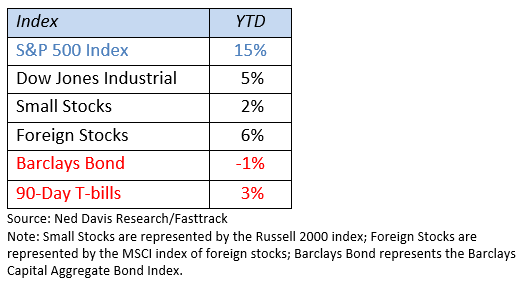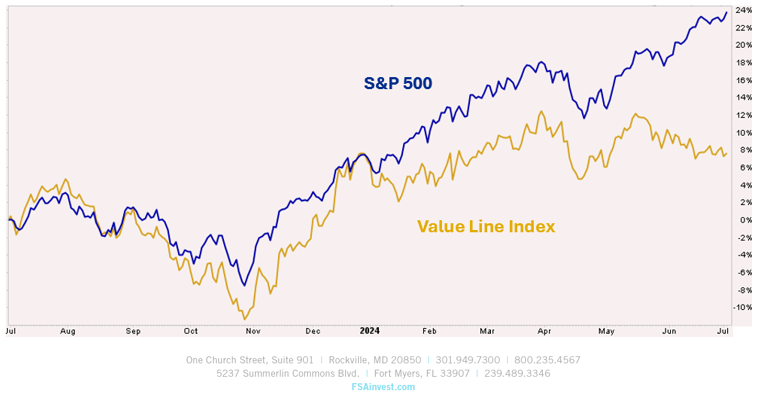While it is clearly not the worst of times for the financial markets, is it really the best of times? It depends on the index you use as a gauge. The S&P 500 Index finished the second quarter up 4% and over 15% for the first half of the year, an excellent result. The Nasdaq Index, chock full of high-flying super-sized technology companies, posted even better results, rising 8% for the quarter and 18% for the year. But are these indexes telling the complete story of how well stocks are faring worldwide? Are these two indexes the most complete representation of stock performance?
The firms that construct the various indices that we use to monitor how stocks are doing can build their indices in a variety of ways. Many are so-called capitalization weighted, meaning the largest companies in the index carry the biggest influence on the returns. The S&P 500 Index is constructed this way, and it generated the returns noted above (and in the table below).
Some providers build their indices giving each company the same weighting for each stock (equal-weighted index). Taking these same 500 companies, but instead of giving a bigger weighting to the bigger companies, giving each company the same weighting, that index was down almost 3% for the quarter and up only 5% for the year.
So, what is the reality? Are stocks up 15% for the year (as represented by the S&P 500) or are they up 5% (as represented by the equal-weight S&P Index)?
The reality is that a handful of the largest companies (including Apple, Microsoft, Nvidia, Google, Meta, and Amazon) dominate the returns of the cap-weighted indices. FSA Investment Analyst, Jordan Daugherty, made the point in last month’s video market update (posted here) that the six largest stocks accounted for 65% of the gain for the index this year. That means that six stocks in the S&P Index accounted for roughly 10% of the S&P Index’s 15% gain. Without those stocks, that S&P Index would have been up only 5%.
At this point, the S&P 500 Index has devolved into a closet technology fund since its returns are dominated by the largest technology-oriented stocks in the index, clearly not a broad representation of the U.S. stock market. So, let’s celebrate the solid returns so far this year, without getting greedy by chasing after the narrowest parts of the market. There’s an adage in investing that says, “Bulls make money, bears make money, but pigs get slaughtered.”

Outlook for the Second Half
From a technical viewpoint, stocks seem capable of maintaining an uptrend. We track several different market risk gauges, and our longer-term monitor remains bullish, as does our shorter-term gauge. As a result, we have the allocation to equities at or near their maximum levels and have been there for much of the year.
Our only real concern is how few stocks are participating in the rally (as noted in the discussion above). The fine folks at Ned Davis Research did a study looking at the percentage of stocks in the S&P 500 Index that have outperformed the index (one might expect half of the companies to underperform and half to outperform). In 2024, we are on pace to see a record low of only 25% of stocks able to outperform the index. Aside from last year, the lowest years before these were 1998 and 1999 (before the internet bubble burst).
Visually, you can see the divergence between the S&P 500 Index, which is dominated by a handful of huge technology companies, and a broader index, such as the Value Line Arithmetic Index, which includes 1700 U.S. stocks and weights each holding equally.

Notice that even though the S&P 500 Index has broken away from the equal-weighted version, this index remains in an uptrend (even though the past quarter has clearly stalled).
Current positive conditions aside, we believe there is the potential for increased choppiness in the second half of the year. The markets will enter a historically weaker period during August through October. And there are several fundamental issues that could disrupt this equity uptrend, including a surprise negative turn in the economic growth numbers or inflation remaining stubbornly high.
Our four-person portfolio management team (consisting of two master’s degree holders and two CFA charter holders) will continue to follow the money, aligning the portfolios with the current leaders, and jettison any security that violates the FSA Safety Net®.
Portfolio Update
Keep in mind that because we manage clients’ portfolios individually, the holdings in your specific accounts may differ somewhat from the averages.
Strategies That Employ the FSA Safety Net®
Income (Strategy 1)
Bonds continued to struggle in the second quarter. The widely followed Barclays Aggregate Bond Index was flat for the quarter; high-yield bonds could only manage a 1% gain. By comparison, money market returns of over 1% look pretty good. Fortunately, we have been able to find some funds able to buck this anemic trend, which helped these portfolios in the quarter.
Income & Growth (Strategy 2)
The portfolios in this strategy were fully invested for most of the quarter, except for some cash raised during the April pullback. We are extra quick to defend this conservative strategy even during mild selloffs. By mid-June, we had the portfolios back at their maximum equity levels. The bond component remains in areas that have fared relatively well in this challenging bond environment.
Conservative Growth (Strategy 3)
These moderate-risk accounts held minimal money market levels all year. During the quarter, we shifted the equity allocation into growth-oriented funds (with higher technology exposure). We also added a small allocation to a commodity fund to potentially benefit from a strong economy or sticky inflation.
Core Equity (Strategy 4)
These equity-oriented accounts continued to perform well, thanks to maintaining a minimal money market allocation, along with a tilt toward growth stocks which have been the market leaders in the past 18 months.
Tactical Growth (Strategy 5)
This has been another strong quarter for the Tactical Growth accounts. While the bulk of the portfolios remain in large-cap and growth-oriented securities, we have dabbled in foreign stocks with mixed results. Our brief foray into the Bitcoin ETFs was also mixed. All in all, these accounts are well positioned for the current environment.
Active Strategies WITHOUT the FSA Safety Net®
Sector Rotation
This disciplined and rules-based strategy continues to struggle in this narrow market. As evidence of how few stocks are participating this year, for the July rotation, the system picked up the inverse S&P 500 fund as one of the six funds. The other five sectors selected for July include technology, semiconductors, internet, telecommunications, and biotechnology.
Global Rotation
For the first time in nearly a year, this rules-based strategy generated a trade. We sold an aggressive growth fund and parked the proceeds in a money market fund (further reflecting the limited opportunities in the stock market). Growth stock funds continue to dominate the portfolio.
Strategies That Remain Fully Invested Through ALL Market Cycles
Global Balanced
Global Balanced is the newest strategy in the FSA line-up, providing a passive allocation of 50% to stocks and 50% to bonds. This strategy is intended for conservative investors looking for a constant allocation to stocks and bonds, provided in a tax-efficient portfolio.
Global Moderate
The narrow stock market (with not many stocks participating), coupled with a challenging time for bonds, has hampered the returns of these diversified passive strategies. Real estate and small cap funds were a drag on returns, while emerging markets and gold provided a lift.
Global Growth
The narrow stock market (with not many stocks participating) has hampered the returns of these aggressive strategies. Real estate and small cap funds were a drag on returns, while emerging markets and gold provided a lift.
Please remember to inform your advisor of any changes in your life that might affect your investment objectives and how we manage your money.
Ronald Rough, CFA
Chief Investment Officer
Disclosures are available at https://fsawealthpartners.com/disclosures/market-update/.
FSA’s current written Disclosure Brochure and Privacy Notice discussing our current advisory services and fees is also available at https://fsawealthpartners.com/disclosures/ or by calling 301-949-7300.




